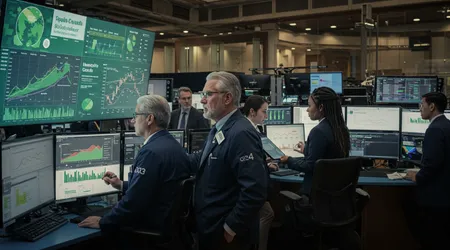The Shift Toward Green Investments in Canadian Financial Markets

Green investments are reshaping Canada’s financial landscape, driven by climate urgency and economic opportunity.
Investors now prioritize sustainability, seeking returns while supporting environmental goals.
This shift reflects global trends, with Canada’s markets adapting to policies, consumer demand, and technological advancements.
In 2025, sustainable finance thrives, but challenges like regulatory clarity and market volatility persist.
This article explores why green investments matter, their impact on Canada’s economy, and how investors can navigate this evolving terrain.
The move toward sustainability isn’t just a trend it’s a necessity. Climate change pressures, coupled with Canada’s Paris Agreement commitments, have spurred action.
Financial institutions, from banks to pension funds, are redirecting capital to renewable energy, green bonds, and sustainable infrastructure.
Meanwhile, retail investors are demanding ESG (Environmental, Social, Governance) options, fueled by awareness and ethical priorities.
But what does this mean for the average Canadian investor? This piece unpacks the drivers, opportunities, and hurdles of green investments, offering a clear path forward.
Why Green Investments Are Gaining Traction in Canada
Canada’s commitment to net-zero by 2050 fuels the rise of green investments. Government policies, like the Sustainable Finance Action Plan, incentivize low-carbon projects.
These initiatives align with global demands for accountability, pushing firms to prioritize sustainability.
Investors see both profit and purpose. Renewable energy stocks, such as Brookfield Renewable Partners, have outperformed traditional energy in recent years.
This reflects a broader shift toward assets promising long-term stability amid climate risks.
Public sentiment also drives change. A 2024 Environics poll found 68% of Canadians want investments aligned with environmental values.
++ Canadian Dollar Volatility: What Exporters and Importers Need to Know
This demand pressures financial advisors to offer greener portfolios, reshaping market dynamics.
Yet, skepticism persists. Some investors question the profitability of green investments, fearing short-term losses.
However, data shows sustainable funds often match or exceed conventional ones, blending ethics with returns.
The analogy of a river helps here: like water carving new paths, capital flows to green investments, reshaping markets. Ignoring this shift risks being left on dry land.

The Role of Policy and Regulation in Shaping Green Finance
Government action is pivotal. Canada’s 2023 Green Bond Framework supports green investments by funding renewable energy and clean transportation.
This clarity attracts institutional investors seeking stable opportunities.
Regulatory bodies are stepping up. The Canadian Securities Administrators now require ESG disclosures, ensuring transparency.
Also read: Canada Imposes Retaliatory Tariffs on U.S.-Made Vehicles: Economic Fallout Expected
This helps investors distinguish genuine sustainability from greenwashing, fostering trust.
Still, gaps remain. Inconsistent provincial regulations create confusion. For example, Alberta’s fossil fuel reliance clashes with British Columbia’s green mandates, complicating national strategies.
Policy evolution is critical. Ottawa’s planned 2025 taxonomy for sustainable investments aims to standardize definitions.
This could unlock billions in capital by clarifying what qualifies as “green.”
Investors benefit from this structure. Clear rules reduce risks, making green investments more accessible. Without them, uncertainty could stall progress, leaving Canada trailing global peers.
Opportunities for Investors in Canada’s Green Market
The green economy offers diverse prospects. Renewable energy firms like Innergex provide stable dividends, appealing to income-focused investors. Their growth mirrors global clean energy demand.
Green bonds are another avenue. In 2024, Canada issued $4 billion in green bonds, funding transit and conservation. These offer fixed returns with lower risk, ideal for cautious investors.
ETFs focused on ESG criteria, such as BMO’s Clean Energy Index ETF, simplify access. They bundle sustainable stocks, reducing research time while diversifying portfolios.
Small-scale investors aren’t left out. Platforms like Wealthsimple offer fractional shares in green companies, lowering entry barriers.
Read more: How Ongoing US-Canada Trade Tensions Are Impacting Consumer Prices in Canada
This democratizes green investments for younger Canadians.
Consider Sarah, a Toronto teacher. She invested $5,000 in a green ETF, balancing ethics and growth. Her portfolio gained 7% in 2024, proving accessibility pays off.
Challenges and Risks in Green Investing
Despite promise, green investments face hurdles. Market volatility, driven by 2025’s tariff wars, impacts renewable energy stocks. Trade disruptions raise costs for solar and wind projects.
Greenwashing remains a concern. Some firms exaggerate ESG credentials, misleading investors. Rigorous due diligence, like checking third-party ESG ratings, is essential to avoid traps.
Liquidity can be an issue. Smaller green firms, unlike blue-chip stocks, may lack trading volume, complicating exits. This risks capital being tied up during downturns.
High upfront costs deter some. Building wind farms or retrofitting buildings requires significant capital, delaying returns. Patience is key, but not all investors can wait.
Regulatory uncertainty adds complexity. Until Canada’s green taxonomy is finalized, investors must navigate ambiguity, relying on advisors to mitigate risks.
The Role of Technology and Innovation

Technology accelerates green finance. AI-driven platforms, like RBC’s Aiden, analyze ESG data, helping investors pick sustainable stocks with precision. This boosts confidence.
Clean tech innovations, such as hydrogen fuel cells, attract capital. Companies like Ballard Power Systems lead here, offering high-growth potential despite early-stage risks.
Blockchain enhances transparency. It tracks green bond proceeds, ensuring funds support stated projects. This builds trust, critical for scaling green investments.
Fintech startups are game-changers. Vancouver’s Carbon Streaming Corp. funds carbon offset projects, blending profit with impact. Such ventures appeal to millennial investors.
Imagine a tech-savvy investor, Alex, using a robo-advisor to build a green portfolio. His $10,000 investment in clean tech grew 12% in 2024, showcasing technology’s edge.
The Economic and Social Impact of Green Investments
Green investments drive economic growth. Canada’s clean energy sector employed 430,000 people in 2024, per Clean Energy Canada, rivaling oil and gas jobs.
Socially, they promote equity. Green projects, like Indigenous-led solar farms, empower communities. These initiatives align profit with social good, resonating with younger investors.
Urban transformation is evident. Toronto’s green infrastructure bonds fund transit upgrades, reducing emissions while improving livability.
This creates a ripple effect on property values.
Job creation extends beyond tech. Retrofitting buildings for energy efficiency demands skilled labor, boosting local economies. This counters fears of job losses in traditional sectors.
Yet, benefits aren’t universal. Rural areas, reliant on fossil fuels, face transition challenges. Bridging this gap requires targeted policies to ensure inclusive growth.
How Investors Can Navigate the Green Shift
Start with education. Understanding ESG metrics, like carbon intensity, helps investors evaluate opportunities. Free resources from CPA Canada offer a solid foundation.
Diversification is key. Mixing green bonds, ETFs, and direct stocks balances risk. For instance, pairing stable bonds with high-growth clean tech mitigates volatility.
Work with advisors. Firms like RBC Wealth Management specialize in sustainable portfolios, tailoring strategies to individual goals while avoiding greenwashing pitfalls.
Monitor policy changes. Subscribing to updates from Environment Canada keeps investors ahead of regulatory shifts, ensuring informed decisions.
Ask yourself: Are you ready to align your wealth with the planet’s future? The tools exist—use them to make green investments work for you.
Table: Key Green Investment Options in Canada (2025)
| Investment Type | Example | Risk Level | Return Potential | Accessibility |
|---|---|---|---|---|
| Green Bonds | Canada Green Bond | Low | 3-5% annually | High |
| Renewable Stocks | Brookfield Renewable | Medium | 8-12% annually | Medium |
| ESG ETFs | BMO Clean Energy ETF | Medium | 7-10% annually | High |
| Clean Tech Ventures | Ballard Power Systems | High | 15%+ annually | Low |
The Future of Green Investments in Canada
The trajectory is clear: green investments will dominate. Global capital flows to sustainability, and Canada’s markets are poised to lead, given our resources and expertise.
Innovation will accelerate. Advances in energy storage, like Quebec’s lithium-ion projects, promise to stabilize renewable grids, attracting more investment.
Consumer demand will grow. As Gen Z enters wealth-building years, their preference for ethical investing will pressure firms to prioritize ESG, reshaping corporate strategies.
International collaboration is vital. Canada’s G7 role in 2025, as noted by BNN Bloomberg, positions it to influence global green finance standards, enhancing market stability.
Challenges won’t vanish. Geopolitical tensions and economic uncertainty could disrupt progress. Yet, the momentum behind green investments suggests resilience, driven by necessity and opportunity.
Conclusion
The shift to green investments in Canada is more than a market trend it’s a transformation of values, economics, and opportunity.
From policy-driven frameworks to tech-enabled portfolios, the tools for sustainable wealth-building are here. Investors face risks, but the rewards financial, social, and environmental are profound.
Sarah and Alex show it’s possible to start small and succeed. As Canada aims for net-zero, every dollar invested in sustainability shapes a better future.
The question isn’t whether to act, but how boldly you’ll embrace this change. Start today, and let your investments reflect your vision for tomorrow.
Frequently Asked Questions
What are green investments?
Green investments fund projects like renewable energy, green bonds, or sustainable infrastructure, aiming for environmental impact and financial returns.
Are green investments profitable?
Yes, many outperform traditional assets. In 2024, Canadian green ETFs averaged 7-12% returns, balancing ethics with growth.
How can I avoid greenwashing?
Check third-party ESG ratings, like MSCI or Sustainalytics, and verify a company’s sustainability claims through transparent disclosures.
Who can invest in green markets?
Anyone, from retail investors using platforms like Wealthsimple to institutions. Options like ETFs make entry accessible.
What’s the biggest risk in green investing?
Volatility and regulatory uncertainty can impact returns. Diversifying and staying informed mitigate these challenges effectively.
